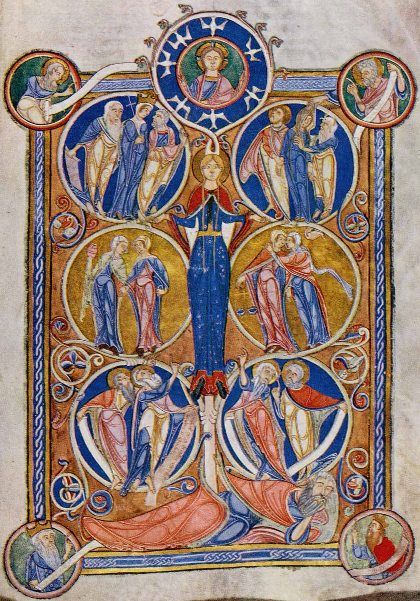Tree of Jesse, Lambeth Psalter, Canterbury c. 1150
Mount Calvary Church
A Roman Catholic Parish
Anglican Use
The Ordinariate of the Chair of S. Peter
Eutaw Street and Madison Avenue
Baltimore, Maryland
Rev. Albert Scharbach, Pastor
December 2, 2018
Advent I
10 A.M. Sung Mass
____________________
Common
Merbecke
___________________
Anthems
William Byrd (1540–1623)
Rorate caeli desuper, et nubes pluant justum: aperiatur terra, et germinet salvatorem. Benedixisti, Domine, terram tuam: avertisti captivitatem Jacob. Gloria Patri, et Filio, et Spiritui Sancto. Sicut erat in principio, et nunc, et semper, et in saecula saeculorum, amen.
Drop down ye heavens, from above, and let the skies pour down righteousness: Let the earth open and bring forth a Saviour. Lord, thou hast blessed thy land: Thou hast turned away the captivity of Jacob. Glory be to the Father, and to the Son, and to the Holy Ghost. As it was in the beginning, is now, and ever shall be, world without end, amen.
Here is the Hereford Cathedral Choir.
__________
William Byrd (1540–1623)
Laetentur coeli, et exultet terra. Jubilate montes laudem, quia Dominus noster veniet, et pauperum suorum miserebitur. Orietur in diebus tuis justitia et abundantia pacis.
Let the heavens be glad and let the earth rejoice. Let the mountains be joyful with praise, because our Lord will come, and will show mercy to his poor. In your days, justice and abundance of peace shall arise.
Here is the choir of Canterbury Cathedral.
____________________
Hymns
Wake, awake, for night is flying (WACHET AUF) is by Philipp Nicolai (1556-1608), translated by Catherine Winkworth (1827-1878). It is partly based on Matthew 25: 1-13, the parable of the wise and foolish virgins. Nicolai was a pastor in Westphalia during a terrible pestilence, which claimed some thirteen hundred lives in his parish alone. Nicolai turned from the constant tragedies and frequent funerals (at times he buried thirty people in one day) to meditate on “the noble, sublime doctrine of eternal life obtained through the blood of Christ.” We look forward to the glorious coming of Jesus when He will deliver us from death and bring us into the kingdom of His Father. Christ’s light shining in the darkness of death to deliver us is a profound theme of Advent.
Hetre is, a capella, the Congregational Church of Batavia. Here, with organ, is St. John’s, Detroit. Here is Wachet auf, the children’s choir of Fulda.
Come, Lord, and tarry not (ST. BRIDE) is by Horatius Bonar (1808–1889). He came from a long line of ministers who served a total of 364 years in the Church of Scotland. the hymn conveys our longing for the coming of Jesus, quoting the last verses of Revelation. It reminds us that Jesus will restore the whole creation, making all things new, abolishing death forever.
Here is the tune.
O Saviour, rend the heaven’s wide (O HEILAND REIß) is Friedrich Spee von Langenfeld (1591-1635). He was a German Jesuit priest, professor, and poet, most noted as an opponent of trials for witchcraft. Spee was the first person in his time to present strong written and spoken arguments against torture, especially with regards to its unreliability in obtaining “truth” from someone undergoing painful questioning. His hymn is based on Isaiah 64: 1 (‘Oh that thou wouldest rend the heavens, that thou wouldest come down’) and the ‘Rorate coeli desuper’ of Isaiah 45: 8 (‘Drop down, ye heavens, from above, and let the skies pour down righteousness’). It is one of the best known and most loved of German Advent hymns: it uses the traditional images of bringing light out of darkness and bringing new life. It conveys the overwhelming power of the Advent of Christ at the end of time, when He will break down the doors of the grave and abolish sin and death forever.
Here is O Heiland, reiss, in Nürnberg at the Friedenskirche. Here is a haunting rendition by the Knabenchor in Dortmund.
Here it is on hammered dulcimer.
